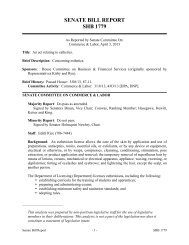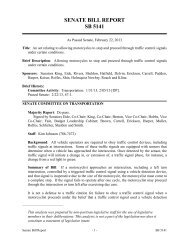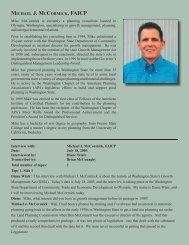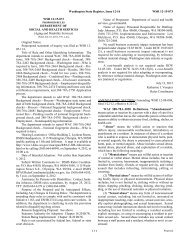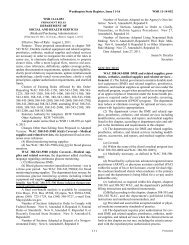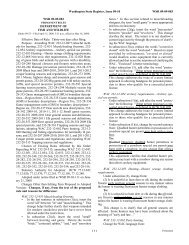Proposed
Proposed
Proposed
You also want an ePaper? Increase the reach of your titles
YUMPU automatically turns print PDFs into web optimized ePapers that Google loves.
WSR 12-21-103 Washington State Register, Issue 12-21<br />
(4) The C.F.R. prescribes that telecommunications service<br />
providers must choose either a MPOE (minimum point<br />
of entry) or CWSTP (cable wire service termination policy)<br />
which regulates where demarcations are placed within a multitenant<br />
environment.<br />
(5) A telecommunications service provider, including its<br />
subcontractors and agents provisioning service for a second<br />
provider who is not the end-user of the service, must place the<br />
point of demarcation no further than twelve inches from the<br />
nearest POP (point of presence), of the serving provider, to<br />
the eventual end-user.<br />
(6) Telecommunications service providers must designate<br />
each building that they provide services to with labeling<br />
at the terminating point(s) of their facilities indicating:<br />
(a) Whether the building is under a MPOE policy; or<br />
(b) Which option of a CWSTP is in effect.<br />
(7) The CWSTP options for demarcation placement are<br />
as follows:<br />
(a) All telecommunications service provider facilities<br />
will terminate at one location, mutually agreed upon by the<br />
provider and the building owner or designee, upon entry into<br />
the building, normally at the lowest common serving point.<br />
All demarcations will be placed no more than twelve inches<br />
from this point. The building owner and/or tenants will provide,<br />
manage and maintain building wire and cable placed<br />
beyond this demarcation point location.<br />
(b) The telecommunications service provider's facilities<br />
will terminate at common locations, mutually agreed upon by<br />
the provider and the building owner or designee, throughout<br />
the building (terminal rooms, utility closets, etc.). The telecommunications<br />
service provider will provide, manage and<br />
maintain the building cable and registration jacks that denote<br />
the demarcation points. The demarcation points will be<br />
placed at these locations and will be accessible to end-users at<br />
these locations. This (b) is not an option for single tenant<br />
buildings.<br />
(c) The telecommunications service provider will terminate<br />
facilities and place demarcations at locations, mutually<br />
agreed upon by the provider and the building owner or designee,<br />
within the individually occupied units, within twelve<br />
inches or a similarly reasonable distance of cable/wire entry.<br />
The provider will provide, manage and maintain the building<br />
cable, network terminating wire and registration jacks that<br />
denote the demarcation point. This (c) is not an option for single<br />
tenant buildings.<br />
(d) All telecommunications service provider facilities<br />
and demarcations will terminate at one location on the property,<br />
mutually agreed upon by the provider and the building<br />
owner or designee. The building owner and/or tenants will<br />
provide, manage and maintain building wire and cable placed<br />
beyond the demarcation point location.<br />
(8) The telecommunications installer must confer with<br />
the telecommunications provider when determining the point<br />
of demarcation.<br />
002 Definitions.<br />
(9) "CWSTP (cable, wire and service termination<br />
policy)" is the policy of the Federal Communications Commission<br />
(FCC) and the Washington utilities and transportation<br />
commission (WUTC) prescribed by tariff that governs<br />
negotiations between building owners and telecommunica-<br />
<strong>Proposed</strong> [ 52 ]<br />
tions service providers regarding the configuration of POP(s)<br />
and demarcation point(s) in multitenant buildings when a<br />
MPOE policy is not elected by the telecommunications service<br />
provider.<br />
(10) "MPOE (minimum point of entry)" is a building<br />
wiring policy of the FCC and WUTC for multitenant environment<br />
locations that can be elected by telecommunications<br />
service providers. It prescribes that the telecommunications<br />
service provider will provide a single POP for access to its<br />
network and is located either at the closest practicable point<br />
to where a telecommunications service provider's facilities<br />
(fiber, coax, or copper) cross a property line or at the closest<br />
practicable point to where the wiring enters a multiunit building<br />
or buildings. All demarcations provided for customers<br />
and end-users by the provider will be placed within twelve<br />
inches of that POP.<br />
(11) "POP (point-of-presence)," also called a "POT<br />
(point-of-termination)," is a designated point at or near a<br />
customer premise at which a telecommunications service<br />
provider's facilities for the provision of access service ends.<br />
This can be a fiber, coax, or copper connection point.<br />
Depending on the telecommunications service provider's<br />
CWSTP with the individual building owner, demarcations<br />
may be established at the POP or at other designated locations.<br />
When the customer of a telecommunications service<br />
provider is another carrier, the demarcation will be at the<br />
closest POP to the end-user. A telecommunications service<br />
provider may have multiple POPs within a multiple tenant<br />
environment.<br />
AMENDATORY SECTION (Amending WSR 08-24-048,<br />
filed 11/25/08, effective 12/31/08)<br />
WAC 296-46B-900 Electrical plan review. Classification<br />
or definition of occupancies.<br />
Classification or definition of occupancies.<br />
(1) Occupancies are classified and defined as follows:<br />
(a) Educational facility refers to a building or portion of<br />
a building used primarily for educational purposes by six or<br />
more persons at one time for twelve hours per week or four<br />
hours in any one day. Educational occupancy includes:<br />
Schools (preschool through grade twelve), colleges, academies,<br />
universities, and trade schools.<br />
(b) Institutional facility refers to a building or portion of<br />
a building used primarily for detention or correctional occupancies<br />
where some degree of restraint or security is required<br />
for a time period of twenty-four or more hours. Such occupancies<br />
include, but are not restricted to: Penal institutions,<br />
reformatories, jails, detention centers, correctional centers,<br />
and residential-restrained care.<br />
(c) Health or personal care facility. Health or personal<br />
care facility refers to buildings or parts of buildings that contain,<br />
but are not limited to, facilities that are required to be<br />
licensed by the department of social and health services or the<br />
department of health (e.g., hospitals, nursing homes, private<br />
alcoholism hospitals, private psychiatric hospitals, boarding<br />
homes, alcoholism treatment facilities, maternity homes,<br />
birth centers or childbirth centers, residential treatment facilities<br />
for psychiatrically impaired children and youths, and<br />
renal hemodialysis clinics) and medical, dental, or chiroprac-



